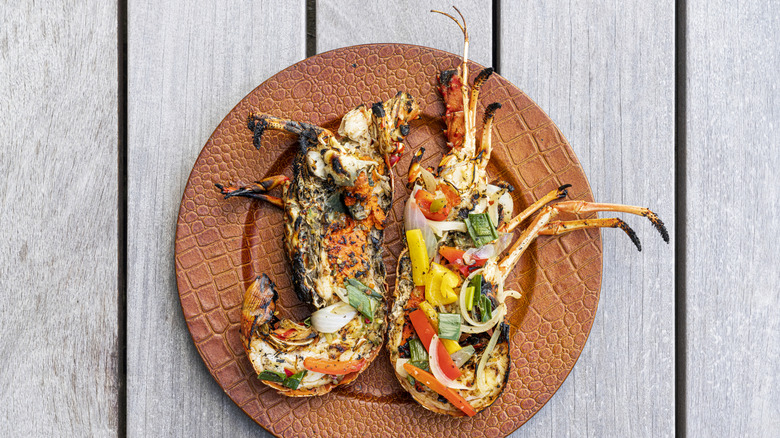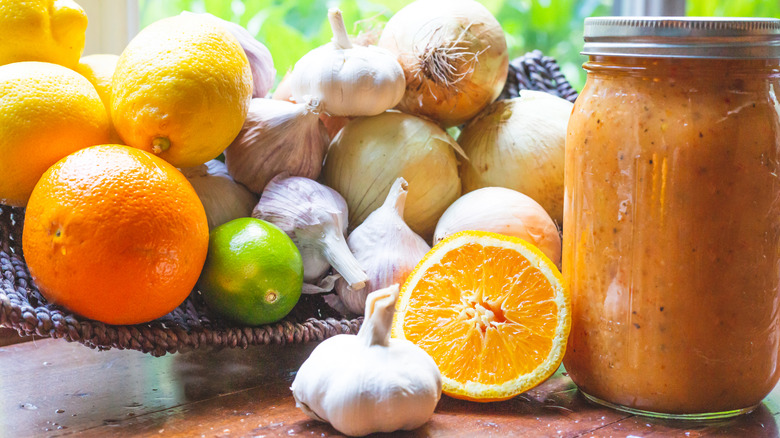The Rich And Flavorful History Of Caribbean Barbecue
We may receive a commission on purchases made from links.
We've probably been arguing about barbecue for as long as humans had the wherewithal to pace around an open flame and poke at chunks of charred meat. To be fair, it's a complex subject with many delicious variables and a difficult history. The transatlantic slave trade brought what we know as succulent, smoky barbecue (like tender pork ribs) to the world, but after that, the debate begins. Some argue barbecue's tangled roots are strictly African, with slaves bringing their barbecue technique to the American South. In 1526, enslaved Africans first came to what we now know as South Carolina, by way of Spaniard Lucas Vasquez de Ayllon. He also brought livestock, and between the Native Americans and the Africans, curbing the new feral pig population was one good reason to roast them over an open fire.
Others point to the Indigenous Taíno people of the Caribbean and their slow-smoking technique via a wooden rack. Both are true. In 1493, Christopher Columbus brought chicken and pigs to the Caribbean, taking with him the Taíno people. Columbus then turned to Africa, and by the 17th century, 40% of enslaved Africans were taken to the Caribbean. The islands were a huge market for slavery, as well as home to many sugar cane plantations that forced African and Caribbean slaves to run them, as well as cook meals. All in all, barbecue is how Afro-Caribbean cuisine was born.
Global influences define the many flavors of Caribbean barbecue
The word "barbecue" comes from the Taíno "barabicu," the Spanish "barbacoa," and the Haitian "barbakoa." You can always count on the islands for original favorites like flavor-packed jerk chicken, pork, or fish, and that's because Jamaican jerk spice is probably the most widely recognized form of Caribbean barbecue. While it's popular globally, the word "jerk" has many connotations. The first one refers to its history as a sustainable food enslaved Africans preserved while escaping Jamaica. It also refers to the technique of seasoning and grilling meat over an open flame, as well as any glaze, sauce, or wet marinade made from the spice blend.
Jerk is infused with the fruity heat of Scotch Bonnet peppers, brought to Jamaica and farmed by the Taíno and then dispersed through the Columbian Exchange. Scotch bonnets are similar to habaneros, but they're sweeter. Allspice is also a must. The Taíno used these berries from the pimento tree to preserve meat and flavor it, but now we savor the dried version for its notes of cinnamon, cloves, fennel, star anise, and black pepper. You'll find both ingredients used throughout the islands in many different ways, depending on the region and the chef. Of course, you'll find barbecue seafood too, marinated and tenderly charred in the Bahamas, then doused with Scilly Cay secret sauce, a lush blend of orange marmalade, peanut butter, tarragon, lime juice, mustard, and honey that's brushed over lobster, shrimp, any fish, and chicken.
Island sauces: Big on the heat and tropical sweetness
Heat is a major player in Caribbean cuisine, especially in the ketchup-based barbecue sauce that can feature tropical fruits like Barbados cherries (Bajan), breadfruit, any citrus, guava, mango, papaya, and of course, pineapple. But there's more. Cuba gives us mojo, and it comes in three variations: criollo, verde, and picón. Mojo criollo includes sour oranges, cumin, oregano, and olive oil. Mojo verde, made bright green from crushed cilantro, uses a big punch of vinegar to polish any smoked meat. You'll find mojo picón (mojo rojo) all over, from Africa to Spain to the Caribbean, as it originated in the Canary Islands. The bright, red, spicy blend features oil, garlic, vinegar, salt, pepper, cumin, coriander, and paprika.
Any discussion about Caribbean barbecue wouldn't be complete without mentioning Trinidad's green sauce, another herby, garlicky marinade-slash-condiment used to marinate everything from oxtails to shrimp. It may also be called Trini sauce or Caribbean sauce. Wasakaka, an addictive Dominican chimichurri of sorts, is made with lime and or sour oranges, garlic, parsley, and olive oil. Puerto Rico is known for its pique, the fiery vinegar sauce with the perfect mouthful of sour, sweet, salty, and hot flavors. And if you've never tried pickliz, a Haitian genius move, go for this crunchy, hot slaw. It's a perfect condiment to any barbecue and another good example of Indigenous Asian influences brought by Chinese and Indian indentured laborers.
Smoke is the common denominator of Caribbean barbecue
Now about those barbecue cooking techniques. The vision of any type of jerk smoking to perfection on the grates of an oil drum grill is a popular sight all over the islands, and this is another effect of history. Oil barrels are everywhere, left over from U.S. military bases and oil refineries built during World War II. Caribbean residents then built grills and drums with them, repurposing them to cook delicious food and make beautiful music. They're usually filled with pimento wood from the Jamaican allspice tree. It lends a subtly sweet and spicy flavor to any Caribbean dish you're trying. Other tropical woods are also used for smoking meats, such as guava and tonka.
If you're a charcoal lover, don't fret, there's plenty of that too. One must-have is the classic island barbecue recipe called Buccaneer chicken that's an homage to the French-Caribbean word for smoke, boucane. Yep, as the buccaneers were pirating, they were also learning to barbecue. It uses charcoal, with strips of sugar cane laid on top of them, and a Caribbean marinade that's out of this world. In Cuba, you'll find pork, roasting to perfection (especially for Noche Buena) on a different type of smoker, in the style of La Caja China. The box with the eponymous name is used for roasting whole pigs (and whatever else) and comes by way of Chinese indentured servants sent to Cuba in the 1800s. You can have a Caja China delivered to your house for about the same cost as a grill or smoker.
DIY or taste your way through these Caribbean barbecue spots closer to home
Today you'll find all sorts of barbecue in the Caribbean, from upscale dining versions to local street vendors using a variety of smoking and grilling techniques. Tradition is the beauty that survives from the ugliness of history, and that's really at the heart of all barbecue. It's all about eating and cooking food the way our families taught us, and sharing and exchanging those delights with others is how cuisine continues to captivate humanity. If you're looking for modern Caribbean barbecue a little closer to home, there's The Jerk Shack in San Antonio, Yaso Jamaican Grill in Indianapolis, or Kokomo in NYC, but really, there's great island barbecue in most cities in the U.S. It just takes that initial, curious search via Google, that goes something like "jerk chicken near me."
Even better, you can get inspired to make your own version of Caribbean barbecue at home. Every ingredient is easy to find, even if you use powdered Scotch bonnet peppers from Amazon. Try these delicious and filling jerk-marinated pork chops for the perfect flavorful meal for any day of the week. Add in a side of Trinidad macaroni pie, and you'll be set. It's a baked mac and cheese casserole that's ultra decadent and uses pimentos (of course), garlic, and lots of spice, proving how Italy is also involved in the history of Caribbean food. But really, everybody knows any good barbecue goes with mac and cheese.




